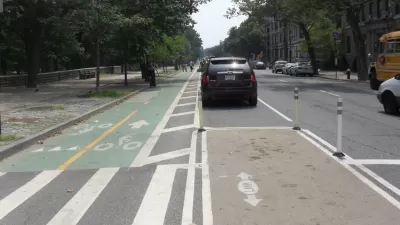Could a recent article in The New York Times that profiled extreme bicycle commutes of up to 40 miles (one way) be harmful to the advancement of bicycle use among ordinary individuals?
In her response to the Times piece that profiled the commuting habits of "Lycra-clad suburbanites" such as Christian Edstrom, who bicycles 80 miles round trip twice a week to his job at JP Morgan, Sarah Goodyear agrees with photographer Dmitry Gudkov's assessment that the story is "completely alienating to 98 percent of people who might want to ride to work."
"Gudkov is right that the image of the road warrior in space-age gear, pedaling a custom-built bike worth thousands of dollars over icy predawn roads, is off-putting to most ordinary folks," argues Goodyear. "And it’s ordinary folks who make up 98 percent of New Yorkers who use bicycles for transportation in New York City."
So, in addition to being alienating, could such portrayals actually be harmful to expanding bike infrastructure?
All bike riders, from the "Type-A strivers on their carbon-fiber steeds" to "the 82-year-old photographer on his cruiser", "benefit from an increased recognition that bicycles are a legitimate way to get from one place to another, and that you don’t have to be some kind of a freak to use them," says Goodyear.
"That recognition is not merely symbolic. It becomes very tangible in the form of protected bicycle infrastructure, such as the trails cited in the Times article, and in pro-bicycle regulations -- such as the Bicycle Access to Office Buildings Law, instituted in 2009, which requires many office buildings to grant access to bikes."
Of note: look for Edstrom's thoughts in the comments section of the article.
FULL STORY: You Don't Have to Be Superhuman to Commute by Bicycle

Maui's Vacation Rental Debate Turns Ugly
Verbal attacks, misinformation campaigns and fistfights plague a high-stakes debate to convert thousands of vacation rentals into long-term housing.

Planetizen Federal Action Tracker
A weekly monitor of how Trump’s orders and actions are impacting planners and planning in America.

In Urban Planning, AI Prompting Could be the New Design Thinking
Creativity has long been key to great urban design. What if we see AI as our new creative partner?

King County Supportive Housing Program Offers Hope for Unhoused Residents
The county is taking a ‘Housing First’ approach that prioritizes getting people into housing, then offering wraparound supportive services.

Researchers Use AI to Get Clearer Picture of US Housing
Analysts are using artificial intelligence to supercharge their research by allowing them to comb through data faster. Though these AI tools can be error prone, they save time and housing researchers are optimistic about the future.

Making Shared Micromobility More Inclusive
Cities and shared mobility system operators can do more to include people with disabilities in planning and operations, per a new report.
Urban Design for Planners 1: Software Tools
This six-course series explores essential urban design concepts using open source software and equips planners with the tools they need to participate fully in the urban design process.
Planning for Universal Design
Learn the tools for implementing Universal Design in planning regulations.
planning NEXT
Appalachian Highlands Housing Partners
Mpact (founded as Rail~Volution)
City of Camden Redevelopment Agency
City of Astoria
City of Portland
City of Laramie



























